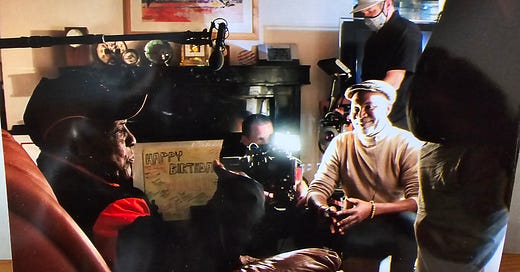I’ve met quite a few legends over the years, but none as universally loved and respected as Willie Howard Mays. I did two long interviews at his home for the ‘Say Hey, Willie Mays’ documentary and both were funny, tough and exciting experiences. Day one Willie treated me like a rookie at spring training. He wanted to know my credentials and if I could hang. Did I know enough to tell his story? I had to push past my awe and deal with him as a elder, a Southerner, and a jock. He’d been doing interviews longer than I’d been alive. Once I got a feel for him, it went well.
Willie hadn’t sat down for lengthy on camera interview in decades, had never allowed folks like us into his home, or told his friends to speak with us. We’d first met in the Giant’s ball park fall of 2019. It was great gathering and we were prepared to start. Then the pandemic hit and were, of course, delayed us. I wondered of it would ever happen. Willie’s eye sight was poor and he only heard well out of one ear. But his spirit was as huge as his massive hands! I’ve never met a normal sized human being with fingers like Willie Mays. He wasn’t a large man, but when you shook his hand you felt every bit of all that Alabama strength. In pictures from the 1950s and ‘60s, Willie had an eight pack, yet apparently didn’t work out. He took pride in saying he had a 32 inch waist when entered the majors and had that same waist when he retired.
There were two organizing themes for the doc based on his life. Number one was that Willie was at the heart of three turning points in sports history: the integration of major league baseball; the live coverage of sports on television; and the move of big league sports to the West Coast.
The other was that Willie’s journey was a reflection of mentorship between fathers and sons, both real and surrogate, that is special to baseball. Willie was taught the game by his father Cat, his Negro Leagues manager Piper Davis, and his first big league manager Leo Durocher. Then Willie became the mentor to a generation of Latin players like Orlando Cepeda, to young outfielder Bobby Bonds, and eventually was named Godfather to his son Barry.
These two ideas, both inspired by Willie’s place in American history, gave the film a narrative spine outside the statistics.
I looking back at the film, I also need to mention the interview with Barry Bonds. He was the last person we interviewed and only after a lot of negotiation handled by HBO, my producer Sean Stuart, and our partners at Spring Hill. Willie’s son Michael also made an important call for us. When he finally agreed I was excited. Then I got Covid!
So I had to do this crucial, exclusive interview via a damn screen. I was worried the would create a barrier between us. But Barry came ready to talk. I asked questions and he took it from there, getting emotional when he talked about his father, Willie, and his love of the game, cementing the mentorship thread I’d been working on with editor Darrin Roberts. Through we did the interview long distance, it was the most moving experience of the entire journey.
There’s a lot more I could say about the making of ‘Say Hey, Willie Mays’ (the music choices, shooting in Birmingham at Rickwood Field, meeting Dusty Baker and other baseball greats), but right now its all about Willie allowing us to celebrate one of the great American lives. I have an autographed Willie Mays baseball on my desk and I’ll treasure it, and the memory of this project, for the rest of my life.
RIP WILLIE HOWARD MAYS
https://play.max.com/movie/96487370-fd0f-41eb-b635-fab751973027
Here’s a link to ‘Say Hey, Willie Mays’ on Max. You can also get at HBO on demand.




